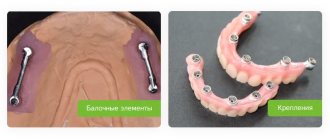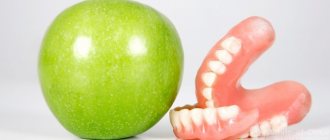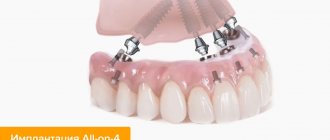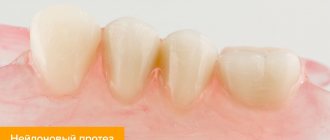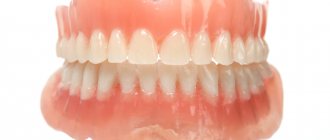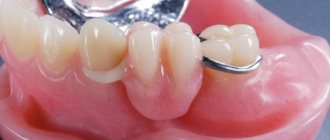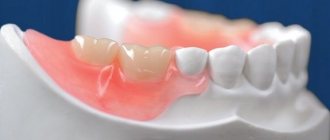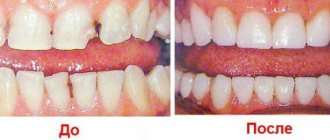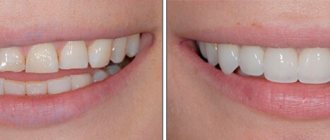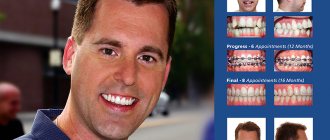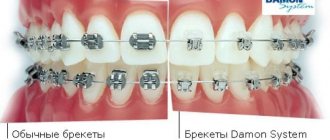Features of the beam system for fixing prostheses
The principle of the technology is implied in the name - a complete removable overdenture is held on implants using a beam fastening. The titanium beam unites the installed implants, distributes the load between them and serves as an element for fixing the prosthesis. The second part of the mechanism is located in the prosthesis itself - a recess is provided in the base corresponding to the shape and size of the beam.
You can remove such a prosthesis yourself, but you do not need to do it every day, as with traditional removable prosthetics. 1-2 times a month is enough to clean the fixation elements.
The beam design is the most reliable of all removable denture options . The beam does not allow the fastening elements to become loose, and breakdowns are excluded. Accepts and evenly distributes vertical load, so bone tissue works not only at the site of implant installation, but throughout the entire jaw, which prevents bone atrophy. With proper use, such .
In most cases, the technology allows you to do without bone grafting and sinus lifting - points on the jaw with sufficient bone volume and density are selected to fix the implants.
Care of bar prosthetic structures
Daily oral hygiene with implants installed is no different from usual. It is enough to brush thoroughly twice a day with a toothbrush and toothpaste and rinse your mouth after eating. Experts advise supplementing daily care by treating the surfaces of the prosthesis and teeth (if any) with an irrigator that supplies a directed stream of water under pressure. Sometimes (at least twice a year) hygienists recommend visiting a dentist, who will carefully remove and clean the denture with special products, and then install it back.
Note: Hygienic care must be carried out regularly, especially with implanted implants. The growth of pathogenic microflora in the oral cavity can provoke infection of the gum tissue and bone, which can result in implant rejection.
The network of dental clinics “Smile” offers patients dental prosthetics services using the implantation method, including the installation of a beam prosthesis on implants. Contacting our branches has significant advantages:
- consultations are conducted by highly qualified doctors;
- diagnostics, treatment and prosthetics are performed in accordance with international standards;
- We provide family and cumulative discounts;
- the cost of dentures depends on the characteristics of the clinical case and the cost of the implant system;
- We work according to a schedule convenient for patients: every day until 21:00 (on Sunday until 16:00).
You can make an appointment at any of the branches of our clinic in Moscow, located within walking distance from metro stations:
- Alekseevskaya (VDNKh district, etc. Mira), address: st. 3rd Mytishchiskaya house 3, building 2;
- Shelepikha, address: Shelepikhinskaya embankment, address: building 34, building 1.
The use of the latest technologies and modern equipment, extensive experience in implantation allows us to quickly perform diagnostics and dental prosthetics based on implants. We guarantee the safety and effectiveness of the services provided. We will restore your self-confidence!
How many implants are needed?
The optimal number of implants is four per jaw . Allows you to correctly distribute chewing loads, avoid atrophy of bone tissue under the prosthesis, and increase the stability and efficiency of the entire structure.
We do not recommend a smaller number - in this case, implants are installed only in the frontal zone, the length of the beam is small. Accordingly, the prosthesis will be unstable in the lateral sections; constant balancing will lead to overload of the implants.
Sometimes six implants may be required for the upper jaw - the bone is softer and looser, so more supports are installed so that the load is distributed evenly.
Contraindications to implantation
- Severe pathologies of the cardiovascular system
- Poor blood clotting
- Bone diseases
- AIDS, HIV
- Oncology
- Diabetes mellitus (uncompensated)
- Allergy to materials used to make prostheses and implants
- Age up to 18 years
- Dental and periodontal diseases
- Alcoholism, drug addiction
- Pregnancy and breastfeeding
Important: contraindications are identified by the implantologist after conducting a visual and hardware examination of the patient, as well as collecting an anamnesis. The network of clinics “Smile” is equipped with modern diagnostic equipment. High accuracy of reading parameters and detailed visualization allow our doctors to make the diagnosis as accurately as possible.
Advantages of bar dentures
A denture with a bar fixation is the best solution of all the options for removable prosthetics on implants
- Convenience Smaller and lighter than traditional ones, more comfortable to use. They do not rest on the gums and do not injure them, and do not move while eating. Easy care.
- Simplicity Implants are placed in points with sufficient jawbone size. There is no need for expensive and complex bone grafting.
- Functionality The load is distributed evenly, the beam transmits pressure not only to the point around the implant, but also to the entire bone. Atrophy is excluded.
- Reliability The structure is strong, the fastenings do not become loose, high stability and chewing efficiency. With proper care it lasts a lifetime.
A prosthesis on a beam is the best of all removable prosthetic options on implants.
The design is reliable due to the beam fixation system. Holds securely and is not subject to overload or breakage.
Levin Dmitry Valerievich Chief physician and founder of the Doctor Levin center
Advantages and disadvantages
In comparison with traditional removable dentures, beam structures on implants benefit from:
- Reliable fixation
- orthopedic devices do not rub the mucous membrane and do not fall out of the mouth even under severe load. - Relatively even distribution
of chewing load.
Its equal share falls on all fixed structures and a small part on bone tissue free from implants - the rate of tissue atrophy slows down
. - Easy to care for
. The design is easy to clean, remove and install without the help of a dentist. You need to care much less often. - Longer service life
, relocations are carried out less frequently.
If over time the patient wants to abandon this system and use implants under another compatible fixed prosthesis, then this can be done without problems.
Stages of prosthetics
Prosthetics itself takes place in one day “in a dream” - we remove failing teeth, install implants, and fix the dentures.
Planning and diagnostics
In our Center, the entire structure is designed by an orthopedic dentist - he calculates the implantation points on the jaw so that after installing the prosthesis, the load is distributed evenly and the principles of biomechanics are observed. It is he who sets the task for the surgical department. This approach guarantees the final result and prevents possible breakdowns of the prosthesis.
The data for calculations are the results of diagnostic studies. Our Center carries out 2 types of diagnostics:
- Computer examination using a 3D tomograph Allows you to evaluate the size of the jaw bone and find suitable points for implantation. The data is also used for 3D surgical planning and production of a surgical template for error-free implant placement.
- Bite studies in an articulator In the absence of teeth, it is difficult to determine the correct closure of the jaws. The only reference point is the position of the TMJ, which is determined as a result of the study. Manufacturing a prosthesis taking into account this parameter ensures a physiological bite after prosthetics and normal functioning of the joint.
Installation of implants and immediate prosthetics
Implantation and removal of failing teeth (if any) are performed under sedation. The operation lasts 1-2 hours. All this time, the patient is in a state of controlled drug sleep, so he can easily endure all the inconveniences.
Immediately after the operation, digital impressions are taken using an intraoral scanner and instantly transferred to the technician in the laboratory. After 2-3 hours, the finished prosthesis is installed on the implants .
This is a temporary lightweight prosthesis - it is not recommended to immediately load implants with a heavy beam structure, because they may become dislodged as a result of strong pressure. Under a small load, the implants take root calmly and safely, a bite is formed, which is taken into account when making a permanent prosthesis.
Permanent prosthetics
After six months, the implants stabilized in the jaw are united by a beam onto which the prosthesis is fixed. In our Center, the beam is milled - it differs from cheaper ones (made by casting or welding) in its high precision of fixation and is not subject to breakage.
The permanent prosthesis is made after prototyping (trying on), the individual bite is taken into account, which eliminates joint and muscle problems during operation.
Crowns as part of the design look natural and are made with individual colors for each patient.
High-quality prosthetics on implants is the result of teamwork among doctors. Each specialist of our Center performs his task in accordance with the Unified Quality Standards and bears responsibility for it.
Work examples
All works
Complex implantation (top and bottom)
Simultaneous implantation of two jaws
Full dental implantation and prosthetics
Implantation on 2 jaws with artificial gum Restoration of the upper jaw Full implantation
Implantation for completely edentulous upper jaw
Restoration of two jaws with one-stage implantation using sinus lift
All works
Sign up for a consultation
three ROOTT specialists + diagnostics as a gift
Life time
We work with premium Nobel Biocare implants, and together with the manufacturer we provide a lifetime warranty in the Dr.Levin Lifetime Warranty on the work and the systems themselves.
The service life of the prosthesis depends on compliance with the operating rules. According to statistics, the service life is from 15 years. If you follow the care recommendations and do not miss appointments every six months for routine maintenance, the structure will last a lifetime .
Even if something happens to the prosthesis, it can be replaced (and the beam, if necessary, too). The implants themselves are not removed; a new prosthesis can be installed on them.
